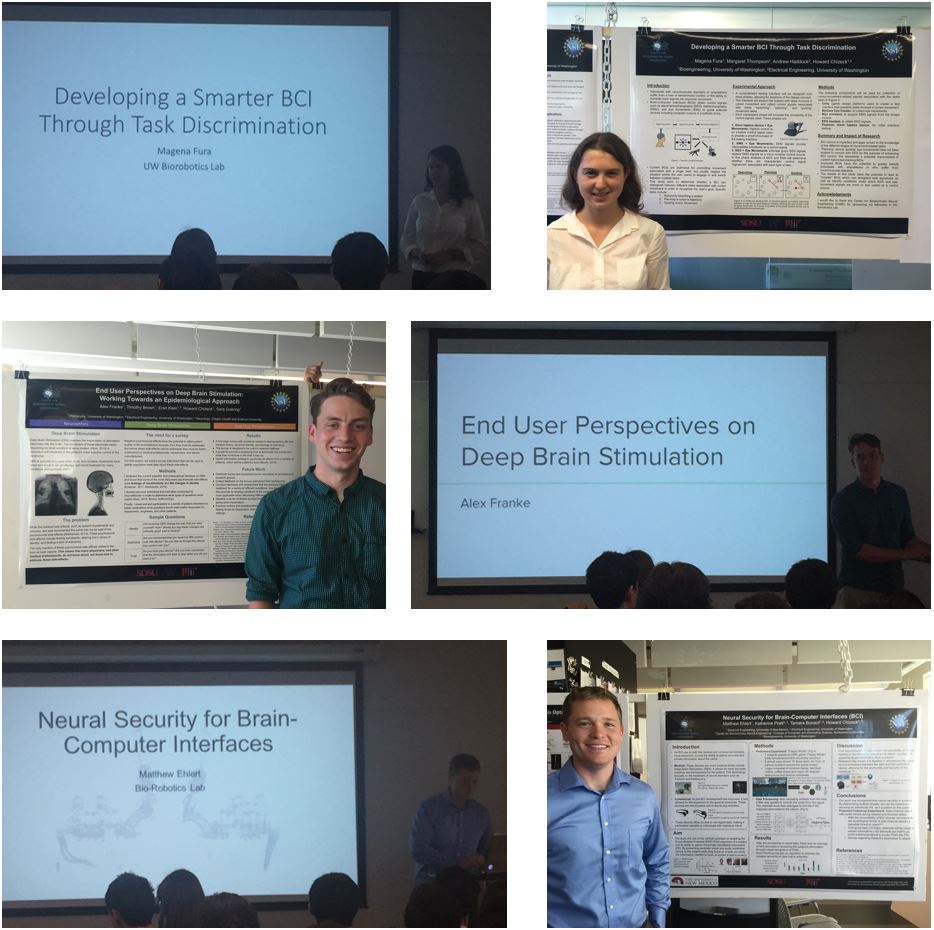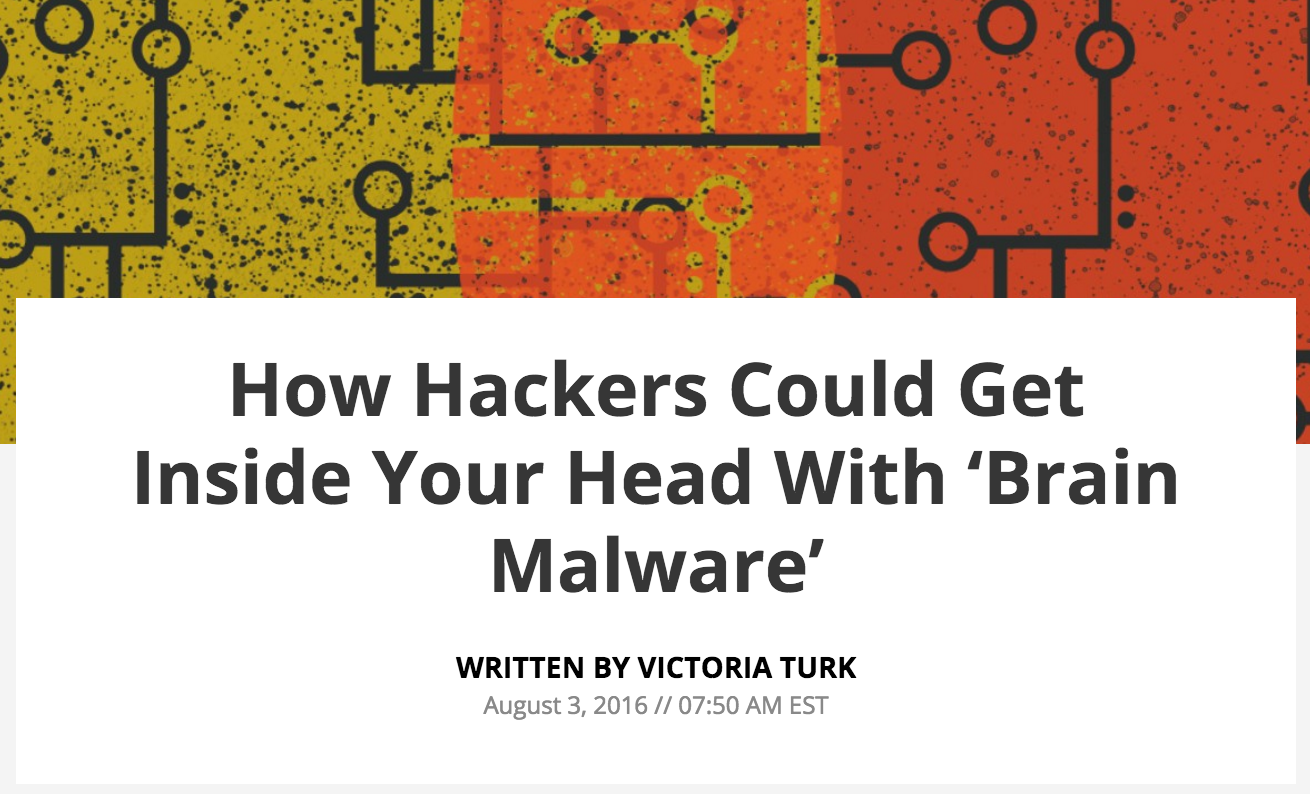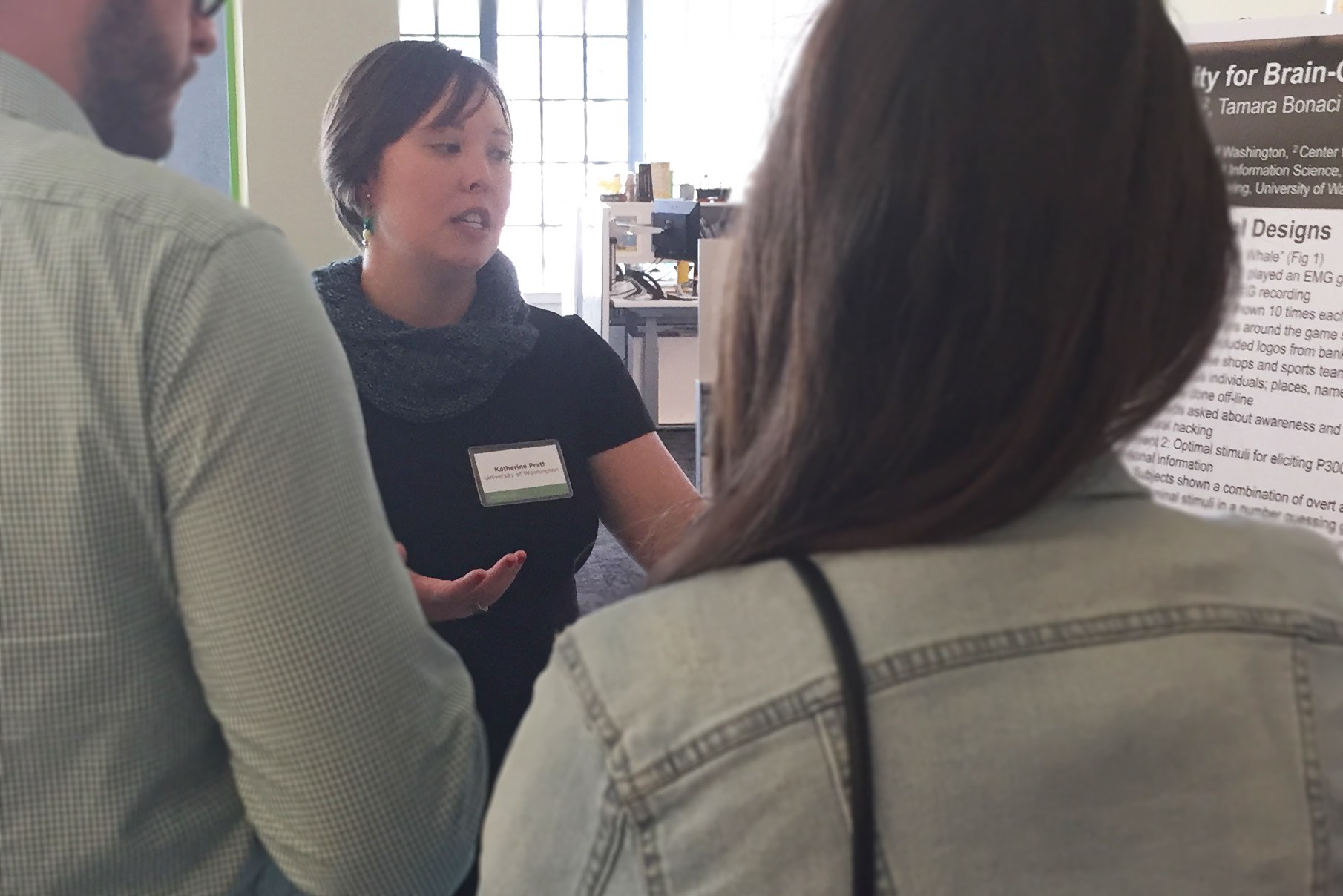A poster detailing a collaborative project lead by Dr. Phil Starr of UCSF will present the first in-human results of the Summit System at the 18th Biennial Meeting of the World Society for Stereotactic and Functional Neurosurgery (WSSFN). Full poster details here
Neural Engineering
Deep Brain Stimulation research from BRL is on the news!
Prof. Howard Chizeck and students of the BioRobotics Lab have developed a method to deliver targeted treatment to people suffering from Essential Tremors using brain signals. They combined electrodes on top of the brain to sense movement in the parts of the body that experience essential tremor, along with a deep brain electrode, to deliver stimulation only when it’s needed.
Here are a few articles from the news:
Top story on NSF’s Science 360 website (June 29): https://news.science360.gov/files/;jsessionid=442F66BBC864503F62F1748A5018342B Direct link:https://news.science360.gov/obj/story/a3d89254-f882-471e-83e4-f66d3dfe8854/brain-signals-deliver-first-targeted-treatment-worlds-common-movement-disorder
National Science Foundation website: https://nsf.gov/news/news_summ.jsp?cntn_id=242397&org=NSF&from=news
Neuroscience News: http://neurosciencenews.com/essential-tremor-dbs-6992/
Health and Medicine News: http://hmnews.org/research-news/cluster947398100/
E Science News: http://esciencenews.com/sources/newswise.scinews/2017/06/27/brain.signals.deliver.first.targeted.treatment.worlds.most.common.movement.disorder
Jersey Tribune: http://jerseytribune.com/2017/06/27/brain-signals-deliver-first-targeted-treatment-for-worlds-most-common-movement-disorder/
Science and Technology Research News: http://www.scienceandtechnologyresearchnews.com/brain-signals-deliver-first-targeted-treatment-worlds-common-movement-disorder/
Science Daily: https://www.sciencedaily.com/releases/2017/06/170627142832.htm
Neuroethics and Engagement Workshop
Last week two of our BRL PhD students presented at the Neuroscience and Ethics Engagement: From Gray Matters to an NSF Engineering Research Center. Maggie Thompson (EE, left) and Tim Brown (Philosophy, right) participated in the Center for Sensorimotor Neural Engineering workshop, and from their website:
This conference gathers experts in the fields of bioethics and neuroethics to think about ways of engaging ethics and science. The conference will take as its starting point recommendations from the Presidential Commission for the Study of Bioethical Issues report, “Gray Matters: Integrative Approaches for Neuroscience, Ethics, and Society.”


Congratulations to our CSNE Summer students!
Last week marked the end of an intensive 10 week summer research program for three of our summer students. Alex and Magena were participants in the CSNE Research Experience for Undergraduates, and Matt was a participant in the CSNE Research Experience for Veterans. All three did a fantastic job of delivering a short presentation and then presenting posters. Thanks for all of your hard work this summer and good luck!

Final presentations for summer research students
We are proud to announce that two of our summer researchers, Matt Ehlert and Alex Franke, will be presenting their research at the CSNE Summer Program Research Symposium. Their poster session is 1-3pm at CSNE (see flyer for more details). Congrats to both of them on their fabulous research!

Neural Security in the news

When VICE Motherboard visited us last month to talk about surgical hacking, they also took some time to learn about the lab’s work on neural security and brain hacking. Several articles are now available:
VICE Motherboard: How Hackers Could Get Inside Your Head With ‘Brain Malware’
Daily Mail UK: Hackers could get inside your BRAIN: Experts warn of growing threat from monitoring and controlling neural signals
Naked Security by Sophos: How hacking brainwaves could reveal our deeply guarded secrets
This research is by Tamara Bonaci, Katherine Pratt, and Howard Chizeck.
BRL research on telerobotic security featured on VICE Motherboard
UPDATE 7/27/2016
VICE Motherboard has posted several more articles following the YouTube video originally posted. They are part of a larger series, The Hacks We Can’t See.
Why We Should Be a Little Paranoid About Hackers Messing With Robot Surgeons
The Internet of Things Will Turn Large-Scale Hacks into Real World Disasters
Original Post
Victoria Turk of VICE Motherboard interviewed BRL investigators Howard Chizeck, Blake Hannaford, and Tamara Bonaci on the security of teleoperated surgical robots. Tamara demonstrates to Victoria what it would feel like to operate the Raven II surgical robot while it’s under a denial of service attack. You can read VICE Motherboard’s article here, and you can read Tamara’s paper on the subject here.
BRL at NeuroFutures
 Several BRL members attended NeuroFutures 2016 at the Allen Institute here in Seattle to present posters. Katherine Pratt (pictured right) presented work by herself and BRL alum Tamara Bonaci on the neural security of brain computer interfaces. Other posters were:
Several BRL members attended NeuroFutures 2016 at the Allen Institute here in Seattle to present posters. Katherine Pratt (pictured right) presented work by herself and BRL alum Tamara Bonaci on the neural security of brain computer interfaces. Other posters were:
- System Identification for Deep Brain Stimulation Control of Parkinsonian Tremor
- A. Haddock, Electrical Engineering Department and Center for Sensorimotor Neural Engineering at University of Washington; H. Chizeck, Electrical Engineering Department and Center for Sensorimotor Neural Engineering at University of Washington
- Closed-Loop Algorithms and Chronic Brain-Computer Interfacing Using a Deep Brain Stimulator with Electrocorticography
- M. Thompson, University of Washington; J. Herron, Dept. of Electrical Engineering, University of Washington & Center for Sensorimotor Neural Engineering; T. Brown, Dept. of Philosophy, University of Washington & Center for Sensorimotor Neural Engineering; J. Ojemann, Dept. of Neurological Surgery, University of Washington Medical Center & Center for Sensorimotor Neural Engineering; A. Ko, Dept. of Neurological Surgery, University of Washington Medical Center & Center for Sensorimotor Neural Engineering; H. Chizeck, Dept. of Electrical Engineering, University of Washington, Dept. of Bioengineering, University of Washington & Center for Sensorimotor Neural Engineering
- Controlling Our Brains — On the Implications of Brain Computer Interface-Triggered Deep Brain Stimulation for Essential Tremor
- T. Brown, University of Washington Department of Philosophy; M. Thompson, Department of Electrical Engineering, University of Washington; J. Herron, Department of Electrical Engineering, University of Washington; A. Ko, Department of Neurological Surgery, University of Washington; H.J. Chizeck, Department of Electrical Engineering, University of Washington; S. Goering, Department of Philosophy, University of Washington
More information, including full abstracts of the posters mentioned above, as well as more information about the conference, can be found here.
Congrats to a recent BRL graduate
 Congrats to the recent BRL graduate, Jeffrey Herron! He completed his PhD on closed loop deep brain stimulation with Dr Howard Chizeck. He is now working at Medtronic in Minneapolis, MN.
Congrats to the recent BRL graduate, Jeffrey Herron! He completed his PhD on closed loop deep brain stimulation with Dr Howard Chizeck. He is now working at Medtronic in Minneapolis, MN.
Tour the Lab with Facebook Live
Ever been curious what the lab looks like or want to know more about our research? Check out the video of our Facebook Live session, hosted with IEEE. We had a great time showing off our work!